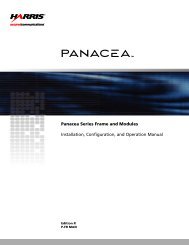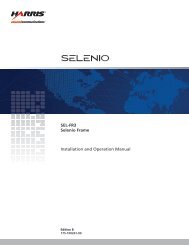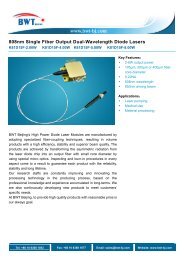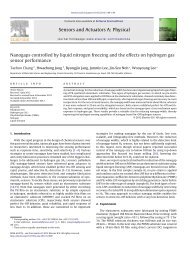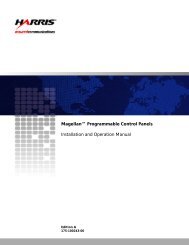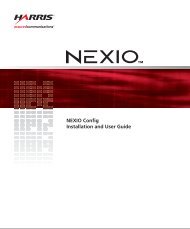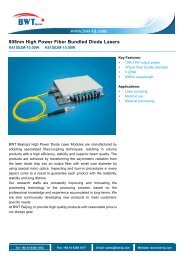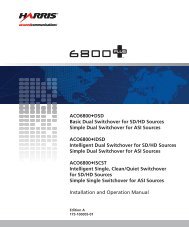Bondyram 4108 MSDS - Biznine.com
Bondyram 4108 MSDS - Biznine.com
Bondyram 4108 MSDS - Biznine.com
Create successful ePaper yourself
Turn your PDF publications into a flip-book with our unique Google optimized e-Paper software.
Material Safety Data Sheet<br />
<strong>Bondyram</strong> ® <strong>4108</strong><br />
Version: 2.0<br />
Validation Date: 02/09/2008 1 / 6<br />
SECTION 1: IDENTIFICATION OF THE SUBSTANCE/PREPARATION AND THE COMPANY/UNDERTAKING<br />
Product information<br />
Trade name : BONDYRAM® modified resin<br />
Type : <strong>Bondyram</strong> <strong>4108</strong><br />
Use of the Substance/Preparation : Resin for molding and/or extrusion<br />
Company<br />
: Polyram Ram-On Industries<br />
Ram On 19205<br />
Israel<br />
Telephone : ++ (972) 4 6599900<br />
Emergency number : ++ (972) 4 6599999<br />
SECTION 2: COMPOSITION/INFORMATION ON INGREDIENTS<br />
Chemical nature : LLD Polyethylene, modified, additives<br />
Components<br />
Chemical Name CAS No. Concentration<br />
LLDPE [9002-88-4] > = 99% wt<br />
Maleic anhydride [108-31-6] < = 1% wt<br />
SECTION 3: HAZARDS IDENTIFICATION<br />
Hazardous classification<br />
Not classified as dangerous goods according to ESIS.<br />
Not classified as hazardous according to criteria of NOHSC.<br />
Specific hazards<br />
Not considered immediately hazardous under normal conditions of use.<br />
Can release irritating and/or toxic fumes and vapors if involved in a fire<br />
SECTION 4: FIRST AID MEASURES<br />
General advice : Remove from exposure, lie down. Never give anything by mouth to an<br />
unconscious person. No hazards which require special first aid measures If a<br />
person vomits when lying on his back, place him in the recovery position.<br />
Skin contact<br />
: Cool skin rapidly with cold water after contact with molten material. Do not peel<br />
polymer from the skin. Obtain medical attention.<br />
Eye contact : Flush eyes with plenty of water. Get medical attention if irritation develops or<br />
persists.<br />
Inhalation<br />
: Move to fresh air in case of accidental inhalation of fumes from overheating or<br />
<strong>com</strong>bustion. Consult a physician after significant exposure.<br />
Ingestion : No hazards which require special first aid measures. Drink water as a precaution.
Material Safety Data Sheet<br />
<strong>Bondyram</strong> ® <strong>4108</strong><br />
Version: 2.0<br />
Validation Date: 02/09/2008 2 / 6<br />
SECTION 5: FIRE FIGHTING MEASURES<br />
Flammability : Combustible<br />
Flash point : 341°C<br />
Auto-ignition temperature : 330 - 410°C<br />
Suitable extinguishing<br />
media<br />
Specific hazards during<br />
fire fighting<br />
Special protective<br />
equipment for fire-fighters<br />
Further information<br />
Special Conditions to Avoid<br />
SECTION 6: ACCIDENTAL RELEASE MEASURES<br />
: Carbon dioxide (CO2), dry powder, foam, water, Halon extinguisher.<br />
: Large molten masses may ignite spontaneously in air. Under conditions giving<br />
in<strong>com</strong>plete <strong>com</strong>bustion, hazardous gases produced may consist of: Organics, Carbon<br />
monoxide. Water quenching is good practice.<br />
: In the event of fire, wear self-contained P1/ P3 breathing apparatus approved by<br />
NIOSH. Watch footing on floors and stairs because of possible melting and<br />
spreading of material. Use water spray to keep containers cool. Wear suitable<br />
protective equipment.<br />
: Fire residues and contaminated fire extinguishing water must be disposed of in<br />
accordance with local regulations. Do not allow run-off from fire fighting to enter<br />
drains or water courses. Hot polyethylene melts and may drop above 120 oC.<br />
: Dust may form explosive mixtures with air. Prevent an exposure to open flames.<br />
Personal precautions : Ventilate the area. Refer to protective measures listed in sections 7 and 8.<br />
Environmental precautions<br />
Methods for cleaning up<br />
: Try to prevent the material from entering drains or water courses. Do not<br />
contaminate surface water.<br />
Additional advice : Use mechanical handling equipment.<br />
SECTION 7: HANDLING AND STORAGE<br />
: Clean up promptly by sweeping or vacuum. Sweep up or vacuum up spillage and<br />
collect in suitable container for disposal.<br />
Handling Procedures and Equipment<br />
Advice on safe handling<br />
: No special handling advice required. In case of insufficient ventilation, wear suitable<br />
respiratory equipment. For personal protection see section 8. Provide appropriate<br />
exhaust ventilation at dryers, machinery and at places where dust or volatiles can be<br />
generated. When opening containers, avoid breathing vapors that may be emanating.<br />
Protect from contamination.<br />
Advice on protection<br />
against fire and explosion<br />
Dust explosion class : no data available<br />
Storage Requirements<br />
Requirements for storage areas<br />
and containers<br />
Other data<br />
: Take necessary action to avoid static electricity discharge (which might cause<br />
ignition of organic vapors).<br />
: Keep container tightly closed in a dry and well-ventilated place. Protect from<br />
contamination. Avoid excessive heat. Do not store near strong oxidizing agents and<br />
other reactants, as described in Section 10.<br />
: No de<strong>com</strong>position if stored and applied as directed. Storage International Classes:<br />
A61B 005/00
Material Safety Data Sheet<br />
<strong>Bondyram</strong> ® <strong>4108</strong><br />
Version: 2.0<br />
Validation Date: 02/09/2008 3 / 6<br />
SECTION 8: EXPOSURE CONTROL / PERSONAL PROTECTION<br />
Components with workplace control parameters<br />
Components Values Control parameters Basis<br />
Maleic anhydride<br />
Engineering measures<br />
TWA A4<br />
not classifiable as<br />
a human carcinogen<br />
1 mg/m 3 (0.25 ppm) NOHSC:<br />
1003(2003)<br />
Dust : Use adequate ventilation during heating processes, or if dusty conditions prevail<br />
when handling powdered materials. For storage and ordinary handling, general<br />
ventilation is adequate.<br />
Personal protective equipment<br />
Respiratory protection : The raw material is <strong>com</strong>posed of pellets and not powder. Hence, on normal<br />
conditions of use the material does not produce dust. However, if dust is<br />
produced, for example in strong abrasive conditions, use appropriate respiratory<br />
protection and refer to the National exposure limits.<br />
Hand protection : Protective heat resistant gloves<br />
Eye protection : Safety glasses with side-shields<br />
Skin and body protection<br />
Hygiene measures<br />
SECTION 9: PHYSICAL AND CHEMICAL PROPERTIES<br />
Physical State : Solid<br />
Odor and appearance : Solid, white pellets. No odor<br />
Odor Threshold : NE<br />
Specific Gravity / Density (20 °C) : 0.91 / 0.93 (g/cm 3)<br />
Vapor Density (Air = 1) : NA<br />
Vapor Pressure (mmHg) : Negligible<br />
Evaporation rate : NE<br />
Boiling Point : NA<br />
Melting point / range : 110-133 °C<br />
Thermal de<strong>com</strong>position : > 250 °C<br />
pH : NA<br />
Coefficient of Water : NA<br />
Solubility in Water (20 °C) : insoluble<br />
: If there is potential contact with hot/molten material, wear heat resistant clothing<br />
and footwear. Regular cleaning of equipment, work area and clothing.<br />
: Do not eat or drink while processing the product; wash hands before breaks.<br />
Keep away from food and drink General precaution for all plastics and<br />
elastomers: Do not breathe fumes evolved from hot polymer.
Material Safety Data Sheet<br />
<strong>Bondyram</strong> ® <strong>4108</strong><br />
Version: 2.0<br />
Validation Date: 02/09/2008 4 / 6<br />
SECTION 10: STABILITY AND REACTIVITY<br />
Stability : The product is stable under ambient conditions.<br />
Conditions to avoid : Avoid heating for prolonged periods above the re<strong>com</strong>mended upper processing limit.<br />
Materials to avoid<br />
Hazardous de<strong>com</strong>position<br />
products<br />
Hazardous reactions : None<br />
: Strong acids, oxidizing agents. Reacts violently with fluorine.<br />
: Aldehydes, alcohols, acrolein and other organic acids.<br />
Further information : During drying, purging and molding, small amounts of hazardous gases and/or<br />
particulate matter may be released. These may irritate eyes, nose and throat. Large<br />
molten masses may give off hazardous gases Water quenching is good practice. No<br />
de<strong>com</strong>position if used as directed.<br />
SECTION 11: TOXICOLOGICAL INFORMATION<br />
Irritability / Corrosiveness : None according to conventional methods<br />
Sensitization : None according to conventional methods<br />
Effect after repeating or<br />
long-term exposure<br />
Carcinogenicity/ mutagenicity/<br />
reproductive toxicity<br />
Further information<br />
Practical Experience<br />
Observation relevant<br />
to classification<br />
: None according to conventional methods<br />
: None according to conventional methods<br />
: None<br />
: NA<br />
Further observation : NA<br />
General remarks : NA<br />
SECTION 12: ECOLOGICAL INFORMATION<br />
Data on elimination<br />
(persistence and degradability)<br />
Procedure in environmental<br />
<strong>com</strong>partments<br />
: No data have been developed on this subject. Not considered biodegradable.<br />
: In case of proper discharge (little concentration) into well adapted sewage<br />
treatment plants, no obstructions of the activated sludge activity will occur<br />
Ecotoxical effects : Aquatic toxicity – none. Reaction in sewage treatment plants do not de<strong>com</strong>pose<br />
Heavy metals content : Free
Material Safety Data Sheet<br />
<strong>Bondyram</strong> ® <strong>4108</strong><br />
Version: 2.0<br />
Validation Date: 02/09/2008 5 / 6<br />
SECTION 13: DISPOSAL CONSIDERATIONS<br />
Product<br />
Contaminated<br />
packaging<br />
Other Disposal<br />
considerations<br />
SECTION 14: TRANSPORT INFORMATION<br />
: Like most thermoplastic plastics the product can be recycled. Where possible<br />
recycling is preferred to disposal or incineration. Do not contaminate ponds,<br />
waterways or ditches with chemical or used container. If recycling is not practicable,<br />
dispose of in <strong>com</strong>pliance with local regulations. Can be landfilled, when in<br />
<strong>com</strong>pliance with local regulations. Discard as non-hazardous organic solid waste.<br />
: Empty containers should be taken for local recycling or waste disposal.<br />
: The information offered here is for the product as shipped. Use and/or alteration to<br />
the product such as mixing with other materials may significantly change the<br />
characteristics of the material and alter the RCRA classification and the proper<br />
disposal method.<br />
Land transport ADR/RID and GGVS/GGVE<br />
US DOT Hazard Class : Not regulated.<br />
US DOT ID Number : Not applicable.<br />
UN – No. : NA. For additional information on shipping regulations affecting this material,<br />
contact the information number found on Section 1.<br />
ADR Classification : No dangerous good<br />
Inland waterway transport ADN/ADNR<br />
UN – No. : NA<br />
ADR Classification : Combustible<br />
Sea transport IMDG / GGVSea<br />
UN – No. : NA<br />
Marine pollutant : None pollutant<br />
Packaging group : NA<br />
Air transport ICAO- TI and IATA -<br />
DGR<br />
Classification : Combustible<br />
Packaging group : NA<br />
Transport / further information<br />
Special Shipping Notes : This product is not regulated by DOT, IMO, IATA, Canadian TDG and associated<br />
regulations, ADR or RID.<br />
EUA : This product is not subject to the requirements of SARA Title III<br />
TSCA SCA<br />
(Toxic Substance Control Act)<br />
Regulations of European<br />
Community Economica<br />
: All the ingredient fulfills with CLEAN WATER ACT: This product is considered<br />
like material floating.<br />
: All the ingredient fulfills with EINCECS / ELINCS Toxic Substance Control.<br />
ACT (TSCA) : Products are listed on the TSCA Chemical Inventory. No other TSCA issues.<br />
For additional information on shipping regulations affecting this material, contact the information number found on Section 1.
Material Safety Data Sheet<br />
<strong>Bondyram</strong> ® <strong>4108</strong><br />
Version: 2.0<br />
Validation Date: 02/09/2008 6 / 6<br />
SECTION 15: REGULATORY INFORMATION<br />
Labeling according to EC-regulations<br />
Hazards symbols and hazard classification – not required.<br />
Hazardous <strong>com</strong>ponent(s) – none hazardous.<br />
R - Phrases substance/preparation – irrelevant.<br />
S - Phrases substance/preparation – S16, S22.<br />
National regulations<br />
Restriction of occupation – None.<br />
Decree of interference/remarks - NA.<br />
Classification according to VbF/remarks – NA.<br />
SECTION 16: OTHER INFORMATION<br />
Reference<br />
SDS of suppliers, Supported by Material data banks. <strong>MSDS</strong> – Polyethylene, Polyram, 30/12/2004.<br />
http://encyclopedia the free dictionary.<strong>com</strong>/list+of+r+phrases.<br />
Abbreviations and<br />
NA = not applicable.<br />
ND = not determined.<br />
NE = not established.<br />
Caution do not use Polyram materials in applications involving implantation within the body; direct or indirect contact<br />
with the blood pathway; contact with bone, tissue, tissue fluid or blood; or prolonged contact with mucous membranes.<br />
Polyram materials are not designed or manufactured for use in implantation in the human body or in contact with<br />
internal body fluids or tissues. Polyram will not provide to customers making devices for such applications any notice,<br />
certification or information necessary for such medical device use required by FDA regulation or any other statute.<br />
Polyram makes no representation, promise, express warranty or implied warranty concerning the suitability of these<br />
materials for use in implantation in the human body or in contact with internal body tissues or fluids.<br />
This information on this <strong>MSDS</strong> was obtained from sources which we believe are reliable. However the information is<br />
provided without any warranty, expressed or implied, regarding its correctness. Some information presented and conclusions<br />
drawn herein are from sources other than direct test data on the substance itself. The conditions or methods of handling,<br />
storage, use and disposal of the product are beyond our control and may be beyond our knowledge. For this and other<br />
reasons we do not assume responsibility and expressly disclaim liability for loss, damage or expense arising out of or in any<br />
way connected with handling storage, use or disposal of this product.<br />
This <strong>MSDS</strong> was prepared and is to be used only for this product. If the product is used as a <strong>com</strong>ponent in another product,<br />
this <strong>MSDS</strong> information may not be applicable.<br />
Preparation date of <strong>MSDS</strong><br />
Prepared by : Olga Kleinerman (Research and Development Department)<br />
Phone Number of Preparer : ++ (972) 4 649959<br />
END OF DOCUMENT



